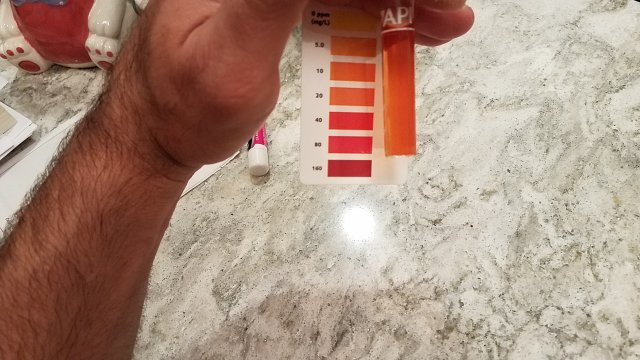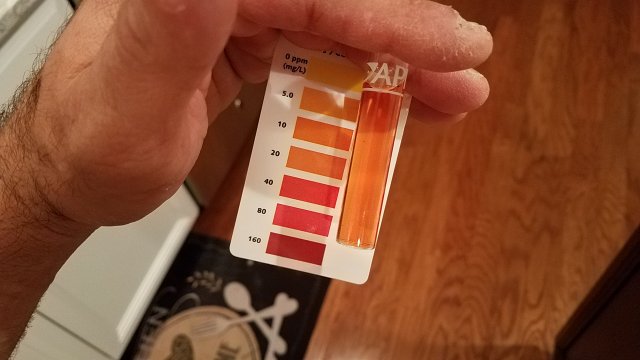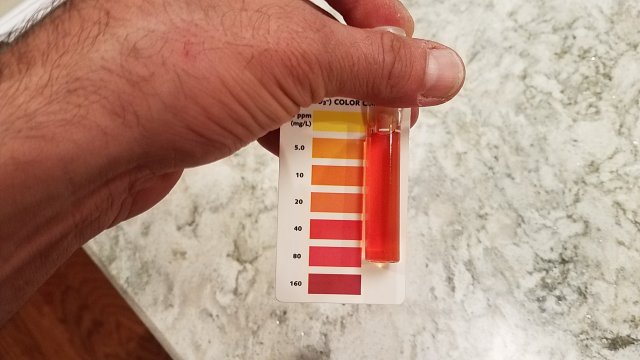Nitrate test kit question
- Thread starter jaws7777
- Start date
You are using an out of date browser. It may not display this or other websites correctly.
You should upgrade or use an alternative browser.
You should upgrade or use an alternative browser.
When the tube is away from the paper you are getting more light shined through the vile, making it appear lighter. I believe standard procedure is against the paper. This is a good example of one source of inaccuracy using home-use colorimetric water testing. More expensive/accurate units put the vial in a dark chamber and shine a light of known intensity through it.
I noticed exactly the same thing a few months ago and posted just like you have. It says on the instructions "the tube should be viewed against the white area beside the colour chart". But as we've found out much to our confusion close up to said background and an inch away from said background give two very very different readings. That instruction they give plus the close similarity between three of the orange shades and two of the red shades make it very tricky to test for nitrate. And then other people claim that it's virtually impossible to accurately test for nitrate with a diy kit at home anyway! I mean wtf are we meant to do? In the meantime i'm pretty much with pops in as much that anywhere near red and you know it's water change day.
I noticed exactly the same thing a few months ago and posted just like you have. It says on the instructions "the tube should be viewed against the white area beside the colour chart". But as we've found out much to our confusion close up to said background and an inch away from said background give two very very different readings. That instruction they give plus the close similarity between three of the orange shades and two of the red shades make it very tricky to test for nitrate. And then other people claim that it's virtually impossible to accurately test for nitrate with a diy kit at home anyway! I mean wtf are we meant to do? In the meantime i'm pretty much with pops in as much that anywhere near red and you know it's water change day.
Hahah ur frustration sums up my thoughts pretty well lol.
Yeah the alarm goes off for me at darkish orange but just wanted to hear what others thought abiut the color/distance difference
As stated above to my knowledge you need to put it right up against the white background in a well lit area to get an accurate read. Even than it depends on lighting and personal judgement. Why I really only test for ammonia and nitrite (when a tank is cycling ) Bc those should be at absolute 0 and not open to misinterpretation unlike all the shades of red and orange for nitrate test.
I have extensive training on testing water quality, but I don't do it in our fish room. One of these days I'll measure pH in our tanks! Just look at the tank. If the fish don't look right, you need to do a water change. If the water doesn't look or smell right, do a water change. Use a good water conditioner like prime or safe on the new water.
That said, I would argue the most important value to know is nitrite. It should be zero. If it is non-zero, you are either at the start of the cycling process or you have a problem. If you have an ammonia problem, you can smell it. Nitrite is more of a silent killer and is really only detectable without a kit by symptoms in the fish (heavy breathing and listlessness). Hanna makes a relatively cheap colorimeter for nitrite (link). This tester is far better than the API master kit. But again... anything non-zero and it's time for action... so does it really matter exactly what the value is?
If you REALLY want to test for nitrate, Hanna has a cheap color based method that is better than the API master kit... you may recognize this sort of thing from pool test kits (link). It is better because the color scale by which you judge the sample changes colors WITH the sample as the amount of light hitting both the sample and the color strip changes. Hanna also makes a fairly cheap handheld photometer (link), but we're talking about spending money like a reefer now. The photometer is not as easy to use, but it is expandable, unlike the colorimeter (link). If you are going to do much expanding... i.e. you want to measure a bunch of variables, there are better (cheaper) instruments available.
That said, I would argue the most important value to know is nitrite. It should be zero. If it is non-zero, you are either at the start of the cycling process or you have a problem. If you have an ammonia problem, you can smell it. Nitrite is more of a silent killer and is really only detectable without a kit by symptoms in the fish (heavy breathing and listlessness). Hanna makes a relatively cheap colorimeter for nitrite (link). This tester is far better than the API master kit. But again... anything non-zero and it's time for action... so does it really matter exactly what the value is?
If you REALLY want to test for nitrate, Hanna has a cheap color based method that is better than the API master kit... you may recognize this sort of thing from pool test kits (link). It is better because the color scale by which you judge the sample changes colors WITH the sample as the amount of light hitting both the sample and the color strip changes. Hanna also makes a fairly cheap handheld photometer (link), but we're talking about spending money like a reefer now. The photometer is not as easy to use, but it is expandable, unlike the colorimeter (link). If you are going to do much expanding... i.e. you want to measure a bunch of variables, there are better (cheaper) instruments available.
Thx grinch will read up on those test kits later today may be worth it to spend a little extra just to mess around withI have extensive training on testing water quality, but I don't do it in our fish room. One of these days I'll measure pH in our tanks! Just look at the tank. If the fish don't look right, you need to do a water change. If the water doesn't look or smell right, do a water change. Use a good water conditioner like prime or safe on the new water.
That said, I would argue the most important value to know is nitrite. It should be zero. If it is non-zero, you are either at the start of the cycling process or you have a problem. If you have an ammonia problem, you can smell it. Nitrite is more of a silent killer and is really only detectable without a kit by symptoms in the fish (heavy breathing and listlessness). Hanna makes a relatively cheap colorimeter for nitrite (link). This tester is far better than the API master kit. But again... anything non-zero and it's time for action... so does it really matter exactly what the value is?
If you REALLY want to test for nitrate, Hanna has a cheap color based method that is better than the API master kit... you may recognize this sort of thing from pool test kits (link). It is better because the color scale by which you judge the sample changes colors WITH the sample as the amount of light hitting both the sample and the color strip changes. Hanna also makes a fairly cheap handheld photometer (link), but we're talking about spending money like a reefer now. The photometer is not as easy to use, but it is expandable, unlike the colorimeter (link). If you are going to do much expanding... i.e. you want to measure a bunch of variables, there are better (cheaper) instruments available.
Im mainly using it on a new tank that i dont have a feel for and messing around with nitrate reduction methods. But yeah the api colors are pretty lame





